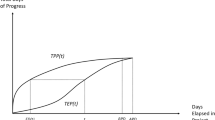Abstract
In this paper, we extensively review and evaluate earned value (EV)-based methods to forecast the total project duration. EV systems have been set up to deal with the complex task of controlling and adjusting the baseline project schedule during execution, taking into account project scope, timed delivery and total project budget. Although EV systems have been proven to provide reliable estimates for the follow-up of cost performance within our project assumptions, they often fail to predict the total duration of the project. We present an extensive simulation study where we carefully control the level of uncertainty in the project, the influence of the project network structure on the accuracy of the forecasts and the time horizon where the EV-based measures provide accurate and reliable results. We assume a project setting where project activities and precedence relations are known in advance and do not consider fundamentally unforeseeable events and/or unknown interactions among various actions that might cause entirely unexpected effects in different project parts. This is the first study that investigates the potential of a recently developed method, the earned schedule method, which improves the connection between EV metrics and the project duration forecasts.








Similar content being viewed by others
References
Anbari FT (2003). Earned value project management methods and extensions. Project Mngt J 34: 12–23.
Christensen DS (1993). The estimate at completion problem: A review of three studies. Project Mngt J 24: 37–42.
Christensen DS, Antolini RC and McKinney JW (1995). A review of EAC research. J Cost Anal Mngt (Spring):41–62.
Cioffi DF (2006). Completing projects according to plans: An earned-value improvement index. J Opl Res Soc 57: 290–295.
Cooper KG (2003). Your project's real price tag—letters to the editor. Harvard Business Review 81: 122.
Covach J, Haydon JJ and Riether RO (1981). A Study to Determine Indicators and Methods to Compute Estimate at Completion (EAC). ManTech International Corporation: Virginia.
Demeulemeester E, Vanhoucke M and Herroelen W (2003). RanGen: A random network generator for activity-on-the-node networks. J Scheduling 6: 13–34.
Elmaghraby SE and Herroelen W (1980). On the measurement of complexity in activity networks. Eur J Opl Res 5: 223–234.
Fleming Q and Koppelman J (2003). What's your project's real price tag?. Harvard Business Review 81: 20–21.
Fleming Q and Koppelman J (2005). Earned Value Project Management, 3rd ed. Project Management Institute: Newtowns Square, PA.
Henderson K (2003). Earned schedule: A breakthrough extension to earned value theory? A retrospective analysis of real project data. The Measurable News (Summer):13–17, 21–23.
Henderson K (2004). Further developments in earned schedule. The Measurable News (Spring):15–16, 20–22.
Henderson K (2005). Earned schedule in action. The Measurable News (Spring):23–28, 30.
Herroelen W and De Reyck B (1999). Phase transitions in project scheduling. J Opl Res Soc 50: 148–156.
Jacob D (2003). Forecasting project schedule completion with earned value metrics. The Measurable News (March): 1, 7–9.
Jacob DS and Kane M (2004). Forecasting schedule completion using earned value metrics… revisited. The Measurable News (Summer):1, 11–17.
Lipke W (2003a). Schedule is different. The Measurable News (Summer): 31–34.
Lipke W (2003b). Deciding to act. Crosstalk 12: 22–24.
Lipke W (2004). Connecting earned value to the schedule. The Measurable News (Winter):1, 6–16.
Loch CH, DeMeyer A and Pich MT (2006). Managing the Unknown: A New Approach to Managing High Uncertainty and Risk in Project. John Wiley and Sons, Inc.: New Jersey.
Patterson JH (1976). Project scheduling: The effects of problem structure on heuristic scheduling. Nal Res Log 23: 95–123.
Tavares LV, Ferreira JA and Coelho JS (1999). The risk of delay of a project in terms of the morphology of its network. Eur J Opl Res 119: 510–537.
Tavares LV, Ferreira JA and Coelho JS (2002). A comparative morphologic analysis of benchmark sets of project networks. Int J Project Mngt 20: 475–485.
Tavares LV, Ferreira JA and Coelho JS (2004). A surrogate indicator of criticality for stochastic networks. Int Transac Opl Res 11: 193–202.
Vandevoorde S and Vanhoucke M (2006). A comparison of different project duration forecasting methods using earned value metrics. Int J Project Mngt 24: 289–302.
Vanhoucke M, Coelho JS, Tavares LV and Debels D (2004). On the topological structure of a network. Working Paper 04/272, Ghent University.
Author information
Authors and Affiliations
Corresponding author
Rights and permissions
About this article
Cite this article
Vanhoucke, M., Vandevoorde, S. A simulation and evaluation of earned value metrics to forecast the project duration. J Oper Res Soc 58, 1361–1374 (2007). https://doi.org/10.1057/palgrave.jors.2602296
Received:
Accepted:
Published:
Issue Date:
DOI: https://doi.org/10.1057/palgrave.jors.2602296




